Management, Leadership & Business Environment: A Costa Coffee Analysis
VerifiedAdded on 2023/06/18
|17
|3620
|379
Report
AI Summary
This report examines the relationship between leadership and management at Costa Coffee, focusing on operational efficiency, community impact, and the wider business environment. It defines different types of leaders and managers, outlining their roles and characteristics, and explores leadership theories such as situational, systems, and contingency leadership, as well as management theories including bureaucratic, scientific, and human relations management. The report provides examples of situations where leaders and managers apply different approaches, such as new product launches and work-from-home scenarios during the pandemic. It also discusses approaches to operations management, including Total Quality Management, Six Sigma, Lean Management, Just-in-Time systems, and Continuous Improvement (Kaizen). Furthermore, the report analyzes the effect of leaders' and managers' decisions on the business environment, covering corporate social responsibility, business ethics, stakeholder concerns, and the importance of operations management in achieving business objectives. This document is available on Desklib, a platform offering AI-based study tools and a wide range of solved assignments for students.
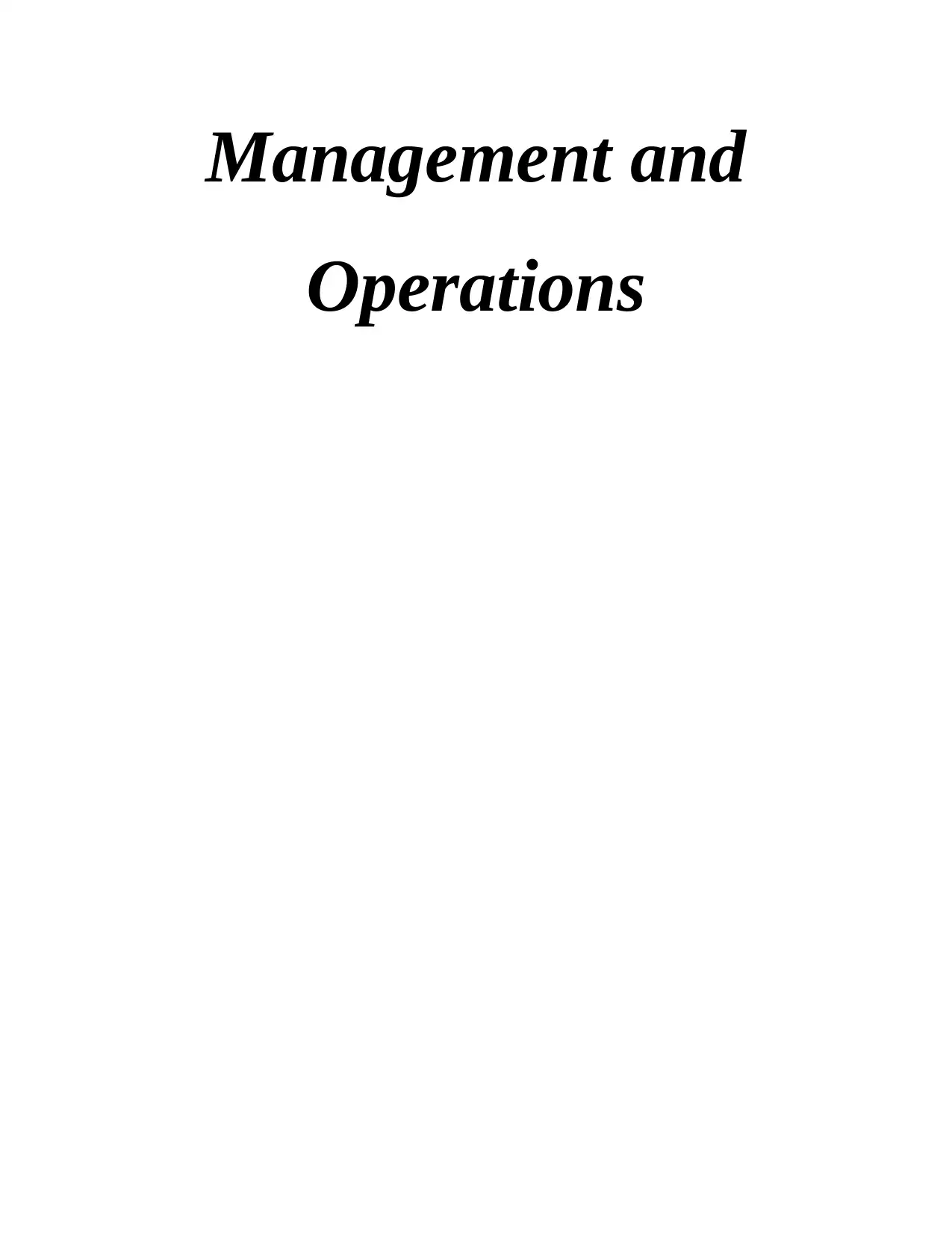
Management and
Operations
Operations
Paraphrase This Document
Need a fresh take? Get an instant paraphrase of this document with our AI Paraphraser

Table of Contents
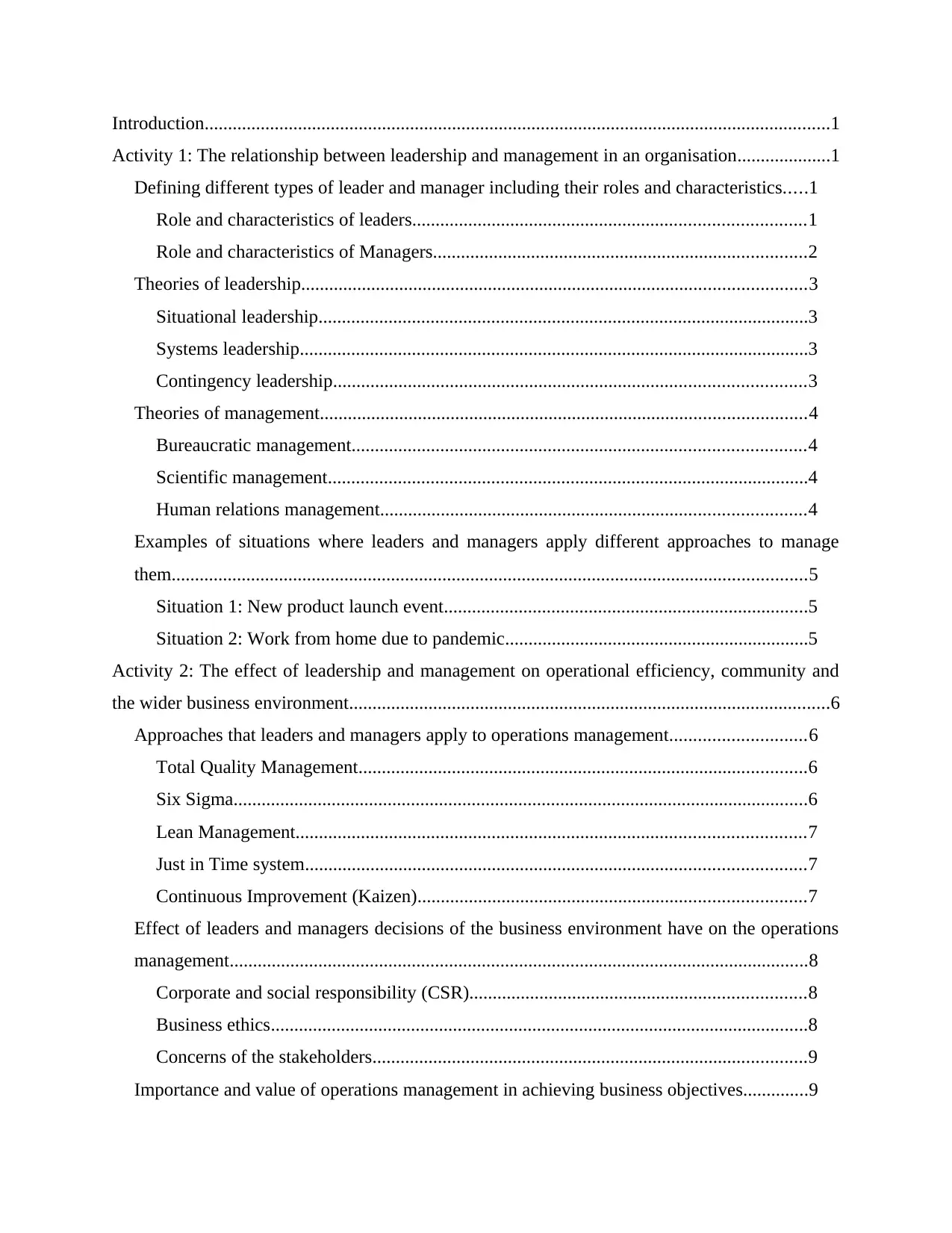
Introduction......................................................................................................................................1
Activity 1: The relationship between leadership and management in an organisation....................1
Defining different types of leader and manager including their roles and characteristics.....1
Role and characteristics of leaders....................................................................................1
Role and characteristics of Managers................................................................................2
Theories of leadership............................................................................................................3
Situational leadership.........................................................................................................3
Systems leadership.............................................................................................................3
Contingency leadership.....................................................................................................3
Theories of management........................................................................................................4
Bureaucratic management.................................................................................................4
Scientific management.......................................................................................................4
Human relations management...........................................................................................4
Examples of situations where leaders and managers apply different approaches to manage
them........................................................................................................................................5
Situation 1: New product launch event..............................................................................5
Situation 2: Work from home due to pandemic.................................................................5
Activity 2: The effect of leadership and management on operational efficiency, community and
the wider business environment.......................................................................................................6
Approaches that leaders and managers apply to operations management.............................6
Total Quality Management................................................................................................6
Six Sigma...........................................................................................................................6
Lean Management.............................................................................................................7
Just in Time system...........................................................................................................7
Continuous Improvement (Kaizen)...................................................................................7
Effect of leaders and managers decisions of the business environment have on the operations
management............................................................................................................................8
Corporate and social responsibility (CSR)........................................................................8
Business ethics...................................................................................................................8
Concerns of the stakeholders.............................................................................................9
Importance and value of operations management in achieving business objectives..............9
Activity 1: The relationship between leadership and management in an organisation....................1
Defining different types of leader and manager including their roles and characteristics.....1
Role and characteristics of leaders....................................................................................1
Role and characteristics of Managers................................................................................2
Theories of leadership............................................................................................................3
Situational leadership.........................................................................................................3
Systems leadership.............................................................................................................3
Contingency leadership.....................................................................................................3
Theories of management........................................................................................................4
Bureaucratic management.................................................................................................4
Scientific management.......................................................................................................4
Human relations management...........................................................................................4
Examples of situations where leaders and managers apply different approaches to manage
them........................................................................................................................................5
Situation 1: New product launch event..............................................................................5
Situation 2: Work from home due to pandemic.................................................................5
Activity 2: The effect of leadership and management on operational efficiency, community and
the wider business environment.......................................................................................................6
Approaches that leaders and managers apply to operations management.............................6
Total Quality Management................................................................................................6
Six Sigma...........................................................................................................................6
Lean Management.............................................................................................................7
Just in Time system...........................................................................................................7
Continuous Improvement (Kaizen)...................................................................................7
Effect of leaders and managers decisions of the business environment have on the operations
management............................................................................................................................8
Corporate and social responsibility (CSR)........................................................................8
Business ethics...................................................................................................................8
Concerns of the stakeholders.............................................................................................9
Importance and value of operations management in achieving business objectives..............9
⊘ This is a preview!⊘
Do you want full access?
Subscribe today to unlock all pages.

Trusted by 1+ million students worldwide
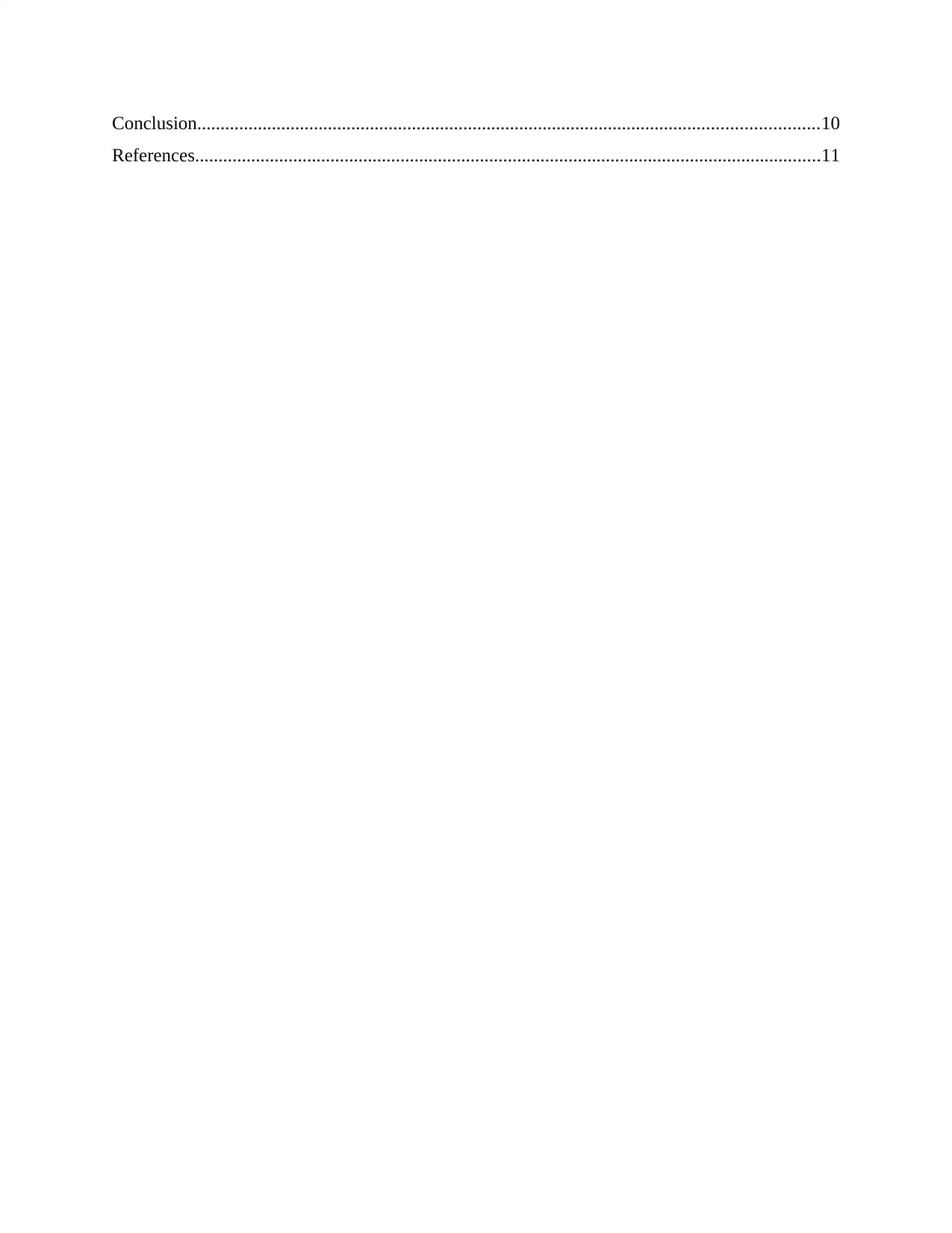
Conclusion.....................................................................................................................................10
References......................................................................................................................................11
References......................................................................................................................................11
Paraphrase This Document
Need a fresh take? Get an instant paraphrase of this document with our AI Paraphraser

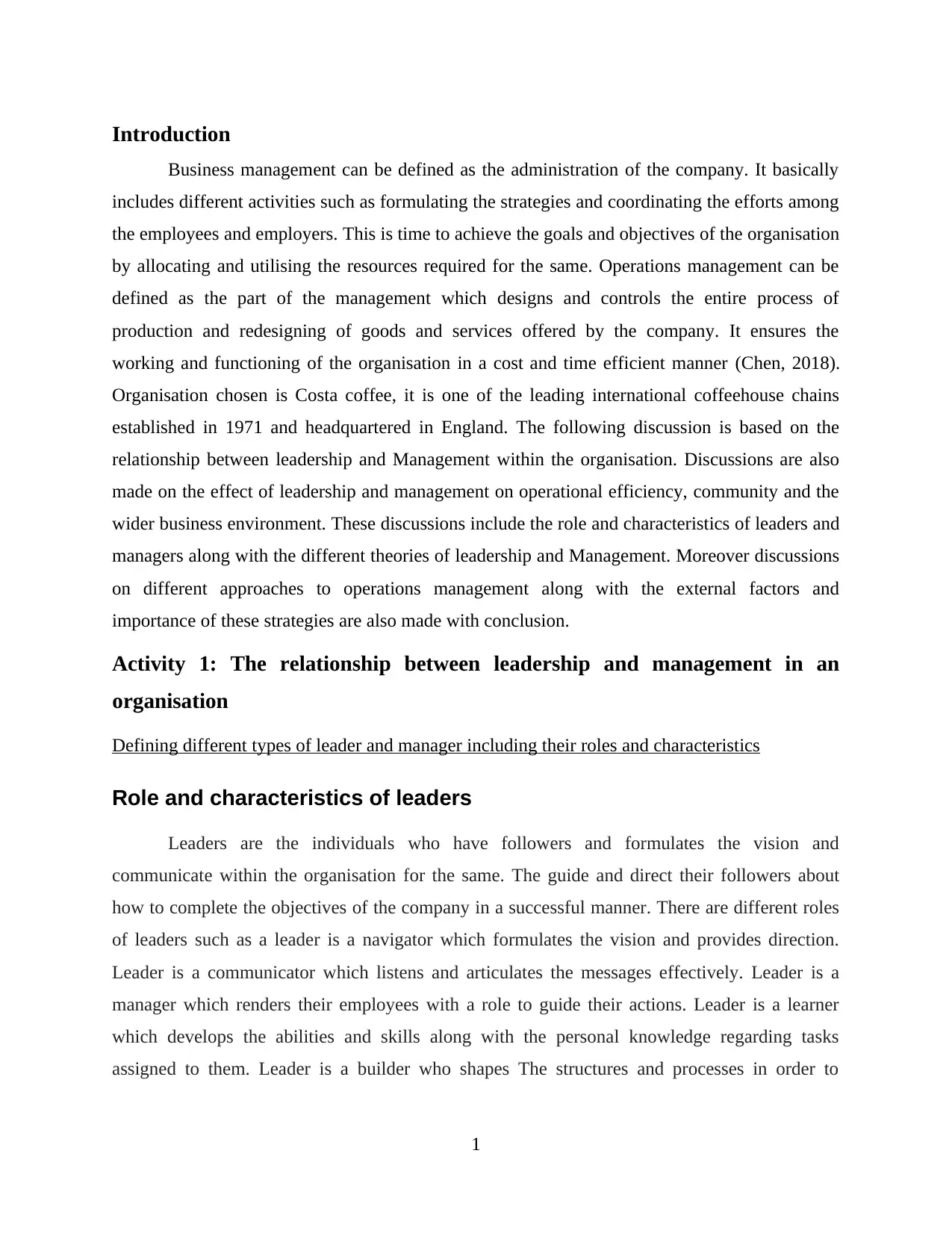
Introduction
Business management can be defined as the administration of the company. It basically
includes different activities such as formulating the strategies and coordinating the efforts among
the employees and employers. This is time to achieve the goals and objectives of the organisation
by allocating and utilising the resources required for the same. Operations management can be
defined as the part of the management which designs and controls the entire process of
production and redesigning of goods and services offered by the company. It ensures the
working and functioning of the organisation in a cost and time efficient manner (Chen, 2018).
Organisation chosen is Costa coffee, it is one of the leading international coffeehouse chains
established in 1971 and headquartered in England. The following discussion is based on the
relationship between leadership and Management within the organisation. Discussions are also
made on the effect of leadership and management on operational efficiency, community and the
wider business environment. These discussions include the role and characteristics of leaders and
managers along with the different theories of leadership and Management. Moreover discussions
on different approaches to operations management along with the external factors and
importance of these strategies are also made with conclusion.
Activity 1: The relationship between leadership and management in an
organisation
Defining different types of leader and manager including their roles and characteristics
Role and characteristics of leaders
Leaders are the individuals who have followers and formulates the vision and
communicate within the organisation for the same. The guide and direct their followers about
how to complete the objectives of the company in a successful manner. There are different roles
of leaders such as a leader is a navigator which formulates the vision and provides direction.
Leader is a communicator which listens and articulates the messages effectively. Leader is a
manager which renders their employees with a role to guide their actions. Leader is a learner
which develops the abilities and skills along with the personal knowledge regarding tasks
assigned to them. Leader is a builder who shapes The structures and processes in order to
1
Business management can be defined as the administration of the company. It basically
includes different activities such as formulating the strategies and coordinating the efforts among
the employees and employers. This is time to achieve the goals and objectives of the organisation
by allocating and utilising the resources required for the same. Operations management can be
defined as the part of the management which designs and controls the entire process of
production and redesigning of goods and services offered by the company. It ensures the
working and functioning of the organisation in a cost and time efficient manner (Chen, 2018).
Organisation chosen is Costa coffee, it is one of the leading international coffeehouse chains
established in 1971 and headquartered in England. The following discussion is based on the
relationship between leadership and Management within the organisation. Discussions are also
made on the effect of leadership and management on operational efficiency, community and the
wider business environment. These discussions include the role and characteristics of leaders and
managers along with the different theories of leadership and Management. Moreover discussions
on different approaches to operations management along with the external factors and
importance of these strategies are also made with conclusion.
Activity 1: The relationship between leadership and management in an
organisation
Defining different types of leader and manager including their roles and characteristics
Role and characteristics of leaders
Leaders are the individuals who have followers and formulates the vision and
communicate within the organisation for the same. The guide and direct their followers about
how to complete the objectives of the company in a successful manner. There are different roles
of leaders such as a leader is a navigator which formulates the vision and provides direction.
Leader is a communicator which listens and articulates the messages effectively. Leader is a
manager which renders their employees with a role to guide their actions. Leader is a learner
which develops the abilities and skills along with the personal knowledge regarding tasks
assigned to them. Leader is a builder who shapes The structures and processes in order to
1
⊘ This is a preview!⊘
Do you want full access?
Subscribe today to unlock all pages.

Trusted by 1+ million students worldwide
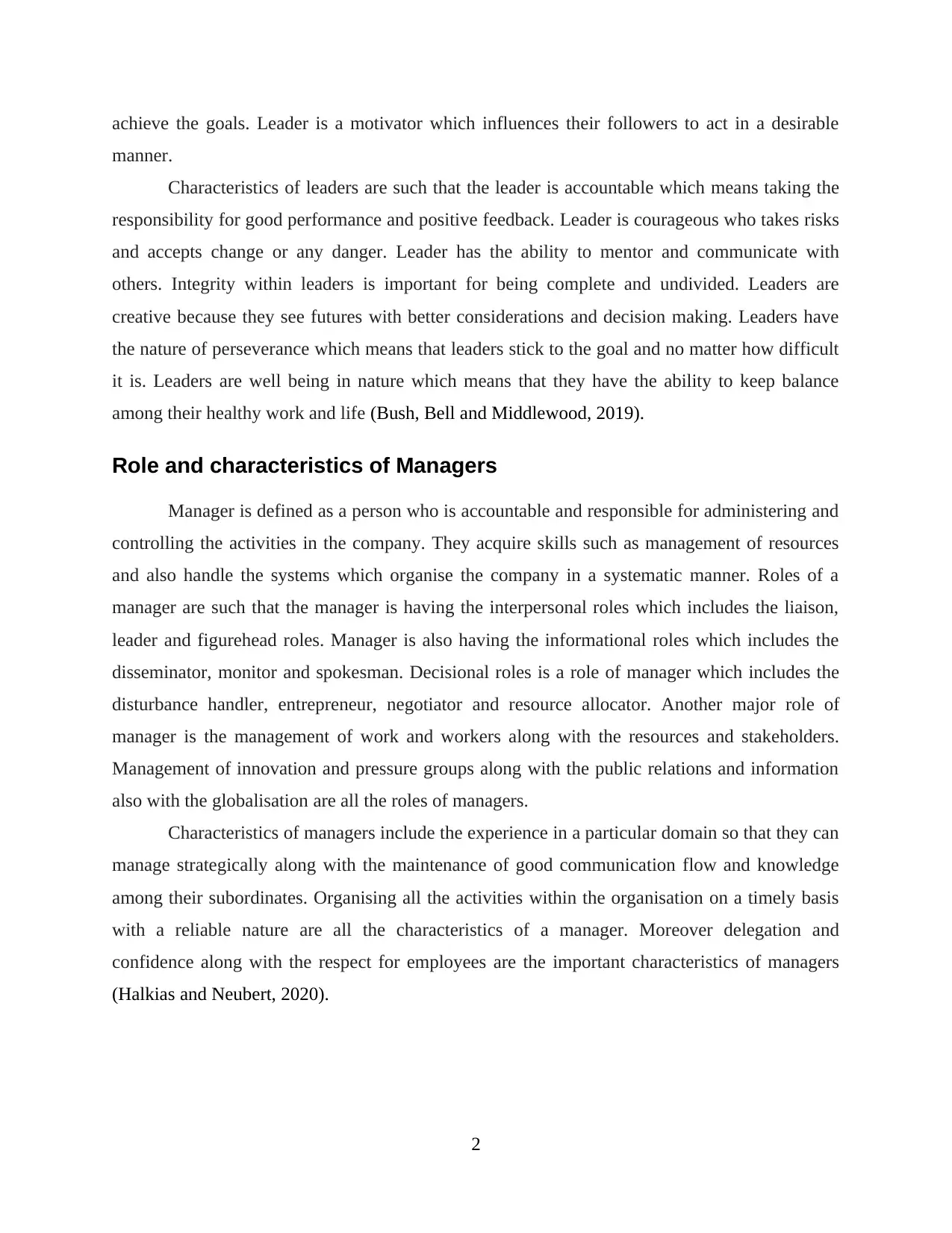
achieve the goals. Leader is a motivator which influences their followers to act in a desirable
manner.
Characteristics of leaders are such that the leader is accountable which means taking the
responsibility for good performance and positive feedback. Leader is courageous who takes risks
and accepts change or any danger. Leader has the ability to mentor and communicate with
others. Integrity within leaders is important for being complete and undivided. Leaders are
creative because they see futures with better considerations and decision making. Leaders have
the nature of perseverance which means that leaders stick to the goal and no matter how difficult
it is. Leaders are well being in nature which means that they have the ability to keep balance
among their healthy work and life (Bush, Bell and Middlewood, 2019).
Role and characteristics of Managers
Manager is defined as a person who is accountable and responsible for administering and
controlling the activities in the company. They acquire skills such as management of resources
and also handle the systems which organise the company in a systematic manner. Roles of a
manager are such that the manager is having the interpersonal roles which includes the liaison,
leader and figurehead roles. Manager is also having the informational roles which includes the
disseminator, monitor and spokesman. Decisional roles is a role of manager which includes the
disturbance handler, entrepreneur, negotiator and resource allocator. Another major role of
manager is the management of work and workers along with the resources and stakeholders.
Management of innovation and pressure groups along with the public relations and information
also with the globalisation are all the roles of managers.
Characteristics of managers include the experience in a particular domain so that they can
manage strategically along with the maintenance of good communication flow and knowledge
among their subordinates. Organising all the activities within the organisation on a timely basis
with a reliable nature are all the characteristics of a manager. Moreover delegation and
confidence along with the respect for employees are the important characteristics of managers
(Halkias and Neubert, 2020).
2
manner.
Characteristics of leaders are such that the leader is accountable which means taking the
responsibility for good performance and positive feedback. Leader is courageous who takes risks
and accepts change or any danger. Leader has the ability to mentor and communicate with
others. Integrity within leaders is important for being complete and undivided. Leaders are
creative because they see futures with better considerations and decision making. Leaders have
the nature of perseverance which means that leaders stick to the goal and no matter how difficult
it is. Leaders are well being in nature which means that they have the ability to keep balance
among their healthy work and life (Bush, Bell and Middlewood, 2019).
Role and characteristics of Managers
Manager is defined as a person who is accountable and responsible for administering and
controlling the activities in the company. They acquire skills such as management of resources
and also handle the systems which organise the company in a systematic manner. Roles of a
manager are such that the manager is having the interpersonal roles which includes the liaison,
leader and figurehead roles. Manager is also having the informational roles which includes the
disseminator, monitor and spokesman. Decisional roles is a role of manager which includes the
disturbance handler, entrepreneur, negotiator and resource allocator. Another major role of
manager is the management of work and workers along with the resources and stakeholders.
Management of innovation and pressure groups along with the public relations and information
also with the globalisation are all the roles of managers.
Characteristics of managers include the experience in a particular domain so that they can
manage strategically along with the maintenance of good communication flow and knowledge
among their subordinates. Organising all the activities within the organisation on a timely basis
with a reliable nature are all the characteristics of a manager. Moreover delegation and
confidence along with the respect for employees are the important characteristics of managers
(Halkias and Neubert, 2020).
2
Paraphrase This Document
Need a fresh take? Get an instant paraphrase of this document with our AI Paraphraser
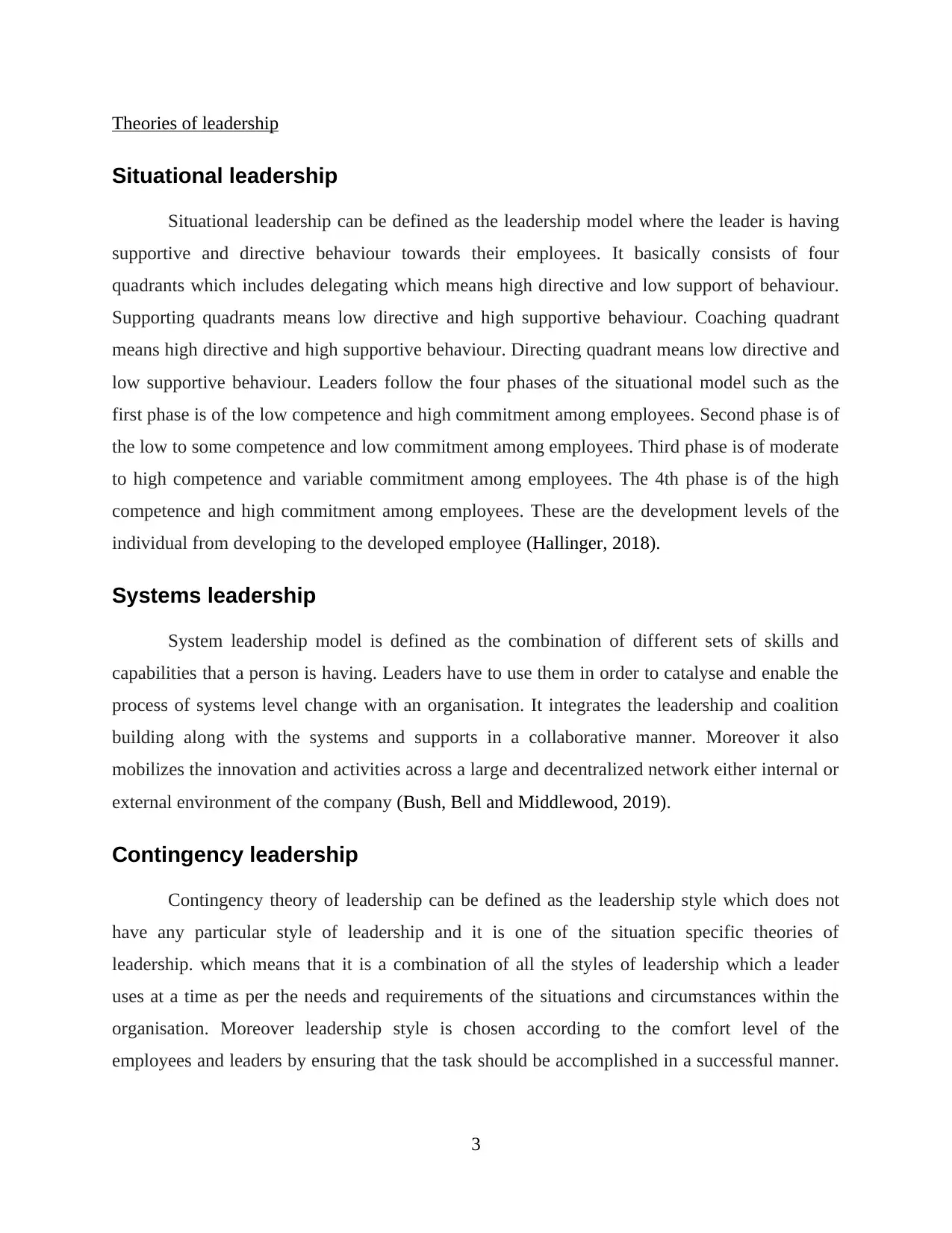
Theories of leadership
Situational leadership
Situational leadership can be defined as the leadership model where the leader is having
supportive and directive behaviour towards their employees. It basically consists of four
quadrants which includes delegating which means high directive and low support of behaviour.
Supporting quadrants means low directive and high supportive behaviour. Coaching quadrant
means high directive and high supportive behaviour. Directing quadrant means low directive and
low supportive behaviour. Leaders follow the four phases of the situational model such as the
first phase is of the low competence and high commitment among employees. Second phase is of
the low to some competence and low commitment among employees. Third phase is of moderate
to high competence and variable commitment among employees. The 4th phase is of the high
competence and high commitment among employees. These are the development levels of the
individual from developing to the developed employee (Hallinger, 2018).
Systems leadership
System leadership model is defined as the combination of different sets of skills and
capabilities that a person is having. Leaders have to use them in order to catalyse and enable the
process of systems level change with an organisation. It integrates the leadership and coalition
building along with the systems and supports in a collaborative manner. Moreover it also
mobilizes the innovation and activities across a large and decentralized network either internal or
external environment of the company (Bush, Bell and Middlewood, 2019).
Contingency leadership
Contingency theory of leadership can be defined as the leadership style which does not
have any particular style of leadership and it is one of the situation specific theories of
leadership. which means that it is a combination of all the styles of leadership which a leader
uses at a time as per the needs and requirements of the situations and circumstances within the
organisation. Moreover leadership style is chosen according to the comfort level of the
employees and leaders by ensuring that the task should be accomplished in a successful manner.
3
Situational leadership
Situational leadership can be defined as the leadership model where the leader is having
supportive and directive behaviour towards their employees. It basically consists of four
quadrants which includes delegating which means high directive and low support of behaviour.
Supporting quadrants means low directive and high supportive behaviour. Coaching quadrant
means high directive and high supportive behaviour. Directing quadrant means low directive and
low supportive behaviour. Leaders follow the four phases of the situational model such as the
first phase is of the low competence and high commitment among employees. Second phase is of
the low to some competence and low commitment among employees. Third phase is of moderate
to high competence and variable commitment among employees. The 4th phase is of the high
competence and high commitment among employees. These are the development levels of the
individual from developing to the developed employee (Hallinger, 2018).
Systems leadership
System leadership model is defined as the combination of different sets of skills and
capabilities that a person is having. Leaders have to use them in order to catalyse and enable the
process of systems level change with an organisation. It integrates the leadership and coalition
building along with the systems and supports in a collaborative manner. Moreover it also
mobilizes the innovation and activities across a large and decentralized network either internal or
external environment of the company (Bush, Bell and Middlewood, 2019).
Contingency leadership
Contingency theory of leadership can be defined as the leadership style which does not
have any particular style of leadership and it is one of the situation specific theories of
leadership. which means that it is a combination of all the styles of leadership which a leader
uses at a time as per the needs and requirements of the situations and circumstances within the
organisation. Moreover leadership style is chosen according to the comfort level of the
employees and leaders by ensuring that the task should be accomplished in a successful manner.
3
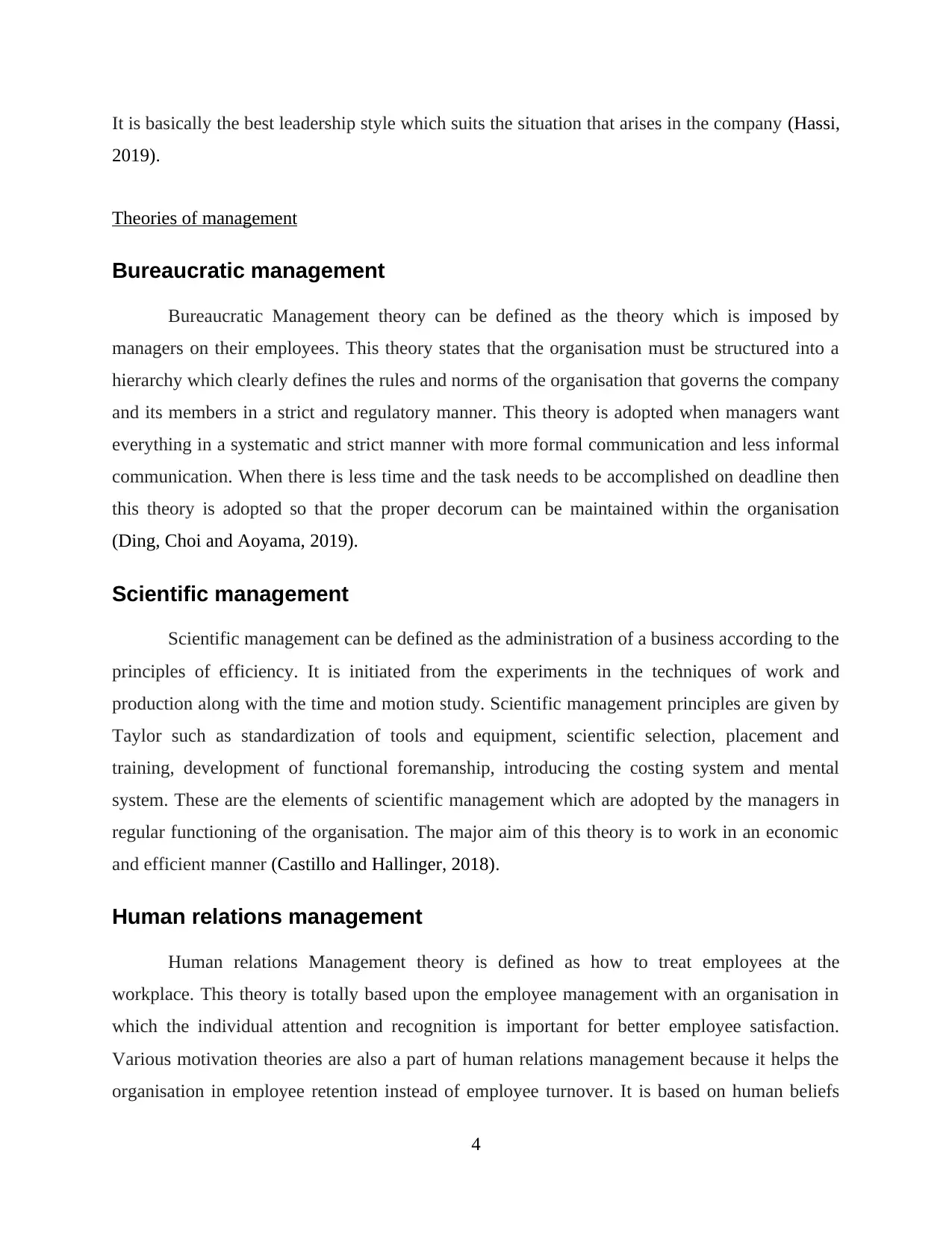
It is basically the best leadership style which suits the situation that arises in the company (Hassi,
2019).
Theories of management
Bureaucratic management
Bureaucratic Management theory can be defined as the theory which is imposed by
managers on their employees. This theory states that the organisation must be structured into a
hierarchy which clearly defines the rules and norms of the organisation that governs the company
and its members in a strict and regulatory manner. This theory is adopted when managers want
everything in a systematic and strict manner with more formal communication and less informal
communication. When there is less time and the task needs to be accomplished on deadline then
this theory is adopted so that the proper decorum can be maintained within the organisation
(Ding, Choi and Aoyama, 2019).
Scientific management
Scientific management can be defined as the administration of a business according to the
principles of efficiency. It is initiated from the experiments in the techniques of work and
production along with the time and motion study. Scientific management principles are given by
Taylor such as standardization of tools and equipment, scientific selection, placement and
training, development of functional foremanship, introducing the costing system and mental
system. These are the elements of scientific management which are adopted by the managers in
regular functioning of the organisation. The major aim of this theory is to work in an economic
and efficient manner (Castillo and Hallinger, 2018).
Human relations management
Human relations Management theory is defined as how to treat employees at the
workplace. This theory is totally based upon the employee management with an organisation in
which the individual attention and recognition is important for better employee satisfaction.
Various motivation theories are also a part of human relations management because it helps the
organisation in employee retention instead of employee turnover. It is based on human beliefs
4
2019).
Theories of management
Bureaucratic management
Bureaucratic Management theory can be defined as the theory which is imposed by
managers on their employees. This theory states that the organisation must be structured into a
hierarchy which clearly defines the rules and norms of the organisation that governs the company
and its members in a strict and regulatory manner. This theory is adopted when managers want
everything in a systematic and strict manner with more formal communication and less informal
communication. When there is less time and the task needs to be accomplished on deadline then
this theory is adopted so that the proper decorum can be maintained within the organisation
(Ding, Choi and Aoyama, 2019).
Scientific management
Scientific management can be defined as the administration of a business according to the
principles of efficiency. It is initiated from the experiments in the techniques of work and
production along with the time and motion study. Scientific management principles are given by
Taylor such as standardization of tools and equipment, scientific selection, placement and
training, development of functional foremanship, introducing the costing system and mental
system. These are the elements of scientific management which are adopted by the managers in
regular functioning of the organisation. The major aim of this theory is to work in an economic
and efficient manner (Castillo and Hallinger, 2018).
Human relations management
Human relations Management theory is defined as how to treat employees at the
workplace. This theory is totally based upon the employee management with an organisation in
which the individual attention and recognition is important for better employee satisfaction.
Various motivation theories are also a part of human relations management because it helps the
organisation in employee retention instead of employee turnover. It is based on human beliefs
4
⊘ This is a preview!⊘
Do you want full access?
Subscribe today to unlock all pages.

Trusted by 1+ million students worldwide
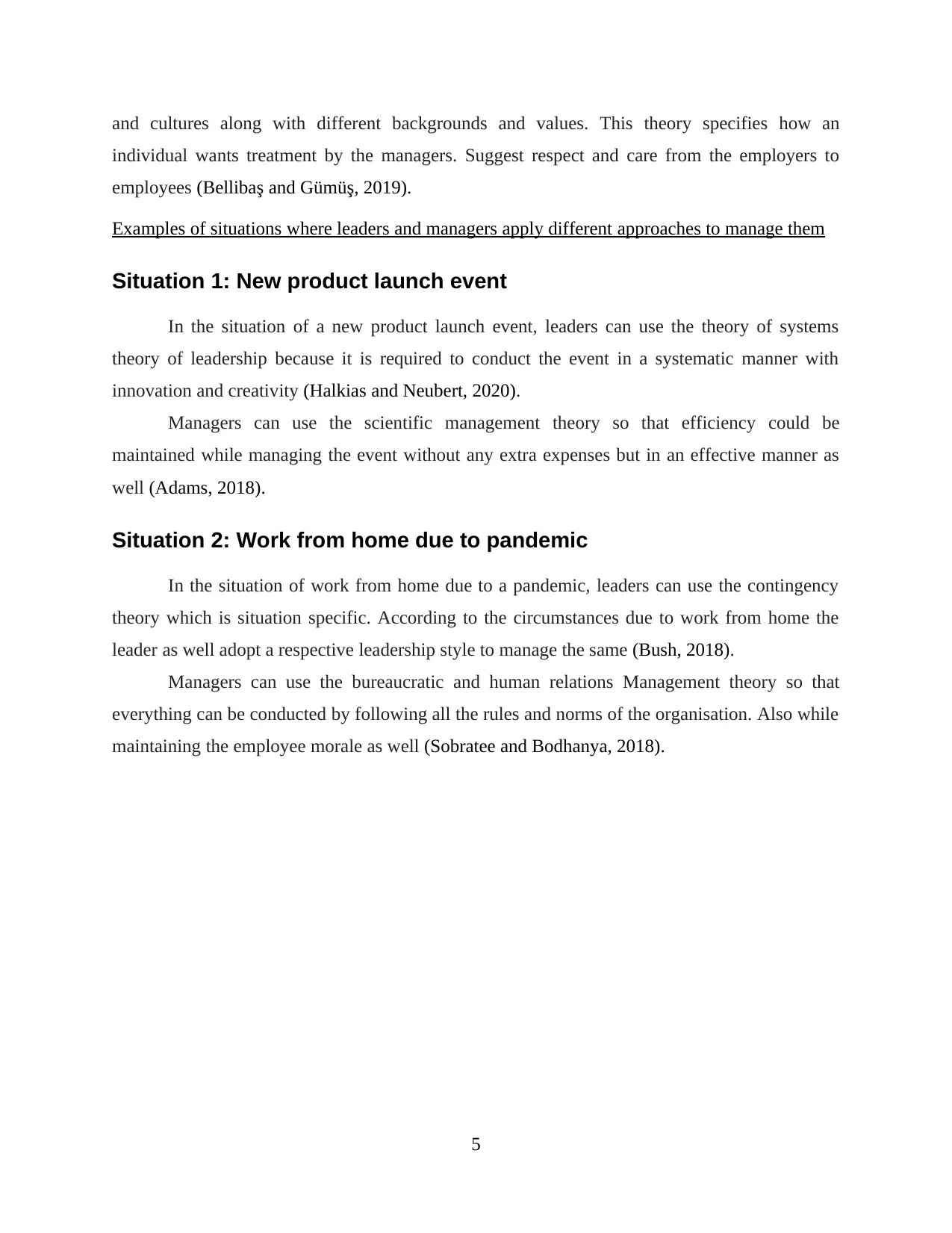
and cultures along with different backgrounds and values. This theory specifies how an
individual wants treatment by the managers. Suggest respect and care from the employers to
employees (Bellibaş and Gümüş, 2019).
Examples of situations where leaders and managers apply different approaches to manage them
Situation 1: New product launch event
In the situation of a new product launch event, leaders can use the theory of systems
theory of leadership because it is required to conduct the event in a systematic manner with
innovation and creativity (Halkias and Neubert, 2020).
Managers can use the scientific management theory so that efficiency could be
maintained while managing the event without any extra expenses but in an effective manner as
well (Adams, 2018).
Situation 2: Work from home due to pandemic
In the situation of work from home due to a pandemic, leaders can use the contingency
theory which is situation specific. According to the circumstances due to work from home the
leader as well adopt a respective leadership style to manage the same (Bush, 2018).
Managers can use the bureaucratic and human relations Management theory so that
everything can be conducted by following all the rules and norms of the organisation. Also while
maintaining the employee morale as well (Sobratee and Bodhanya, 2018).
5
individual wants treatment by the managers. Suggest respect and care from the employers to
employees (Bellibaş and Gümüş, 2019).
Examples of situations where leaders and managers apply different approaches to manage them
Situation 1: New product launch event
In the situation of a new product launch event, leaders can use the theory of systems
theory of leadership because it is required to conduct the event in a systematic manner with
innovation and creativity (Halkias and Neubert, 2020).
Managers can use the scientific management theory so that efficiency could be
maintained while managing the event without any extra expenses but in an effective manner as
well (Adams, 2018).
Situation 2: Work from home due to pandemic
In the situation of work from home due to a pandemic, leaders can use the contingency
theory which is situation specific. According to the circumstances due to work from home the
leader as well adopt a respective leadership style to manage the same (Bush, 2018).
Managers can use the bureaucratic and human relations Management theory so that
everything can be conducted by following all the rules and norms of the organisation. Also while
maintaining the employee morale as well (Sobratee and Bodhanya, 2018).
5
Paraphrase This Document
Need a fresh take? Get an instant paraphrase of this document with our AI Paraphraser
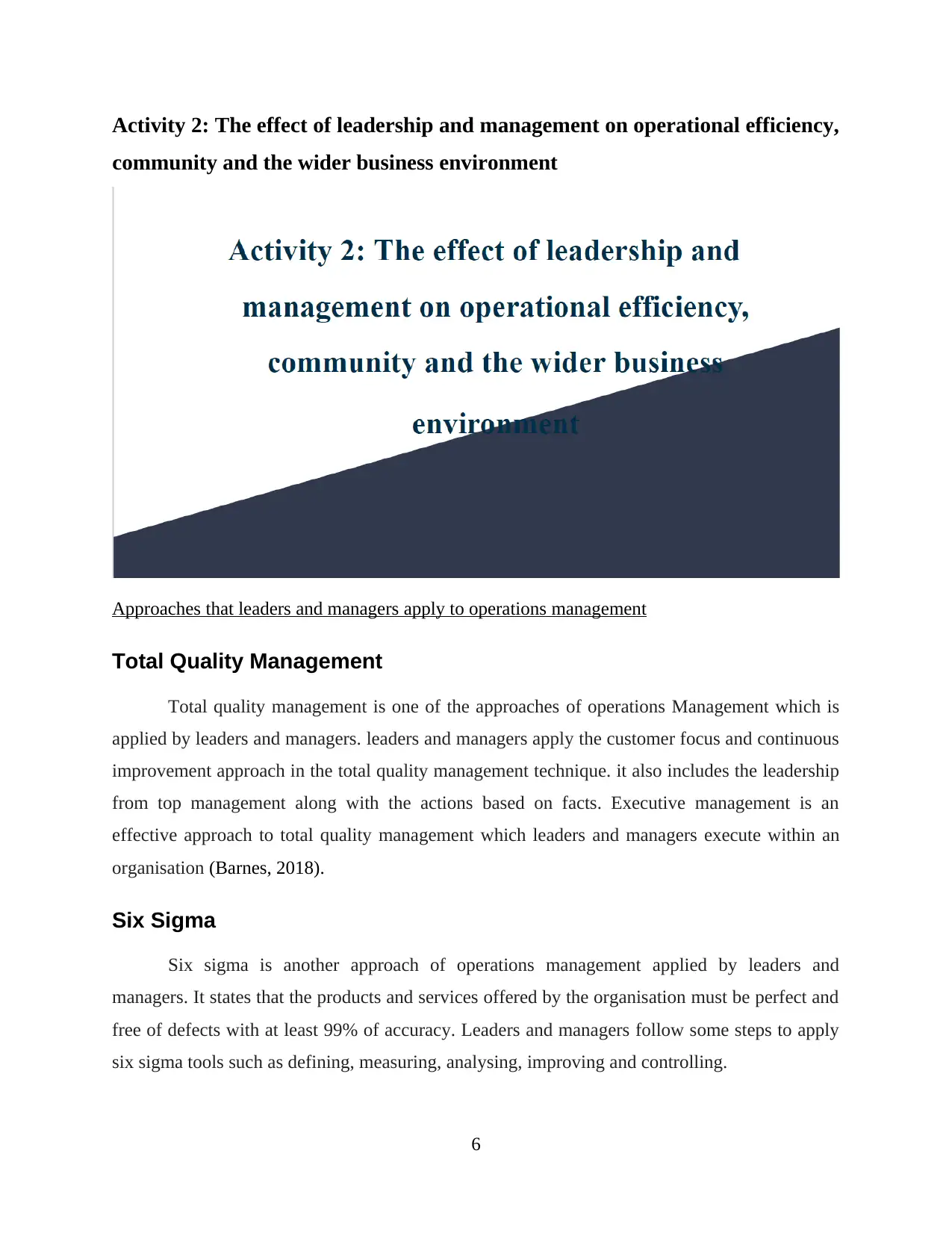
Activity 2: The effect of leadership and management on operational efficiency,
community and the wider business environment
Approaches that leaders and managers apply to operations management
Total Quality Management
Total quality management is one of the approaches of operations Management which is
applied by leaders and managers. leaders and managers apply the customer focus and continuous
improvement approach in the total quality management technique. it also includes the leadership
from top management along with the actions based on facts. Executive management is an
effective approach to total quality management which leaders and managers execute within an
organisation (Barnes, 2018).
Six Sigma
Six sigma is another approach of operations management applied by leaders and
managers. It states that the products and services offered by the organisation must be perfect and
free of defects with at least 99% of accuracy. Leaders and managers follow some steps to apply
six sigma tools such as defining, measuring, analysing, improving and controlling.
6
community and the wider business environment
Approaches that leaders and managers apply to operations management
Total Quality Management
Total quality management is one of the approaches of operations Management which is
applied by leaders and managers. leaders and managers apply the customer focus and continuous
improvement approach in the total quality management technique. it also includes the leadership
from top management along with the actions based on facts. Executive management is an
effective approach to total quality management which leaders and managers execute within an
organisation (Barnes, 2018).
Six Sigma
Six sigma is another approach of operations management applied by leaders and
managers. It states that the products and services offered by the organisation must be perfect and
free of defects with at least 99% of accuracy. Leaders and managers follow some steps to apply
six sigma tools such as defining, measuring, analysing, improving and controlling.
6
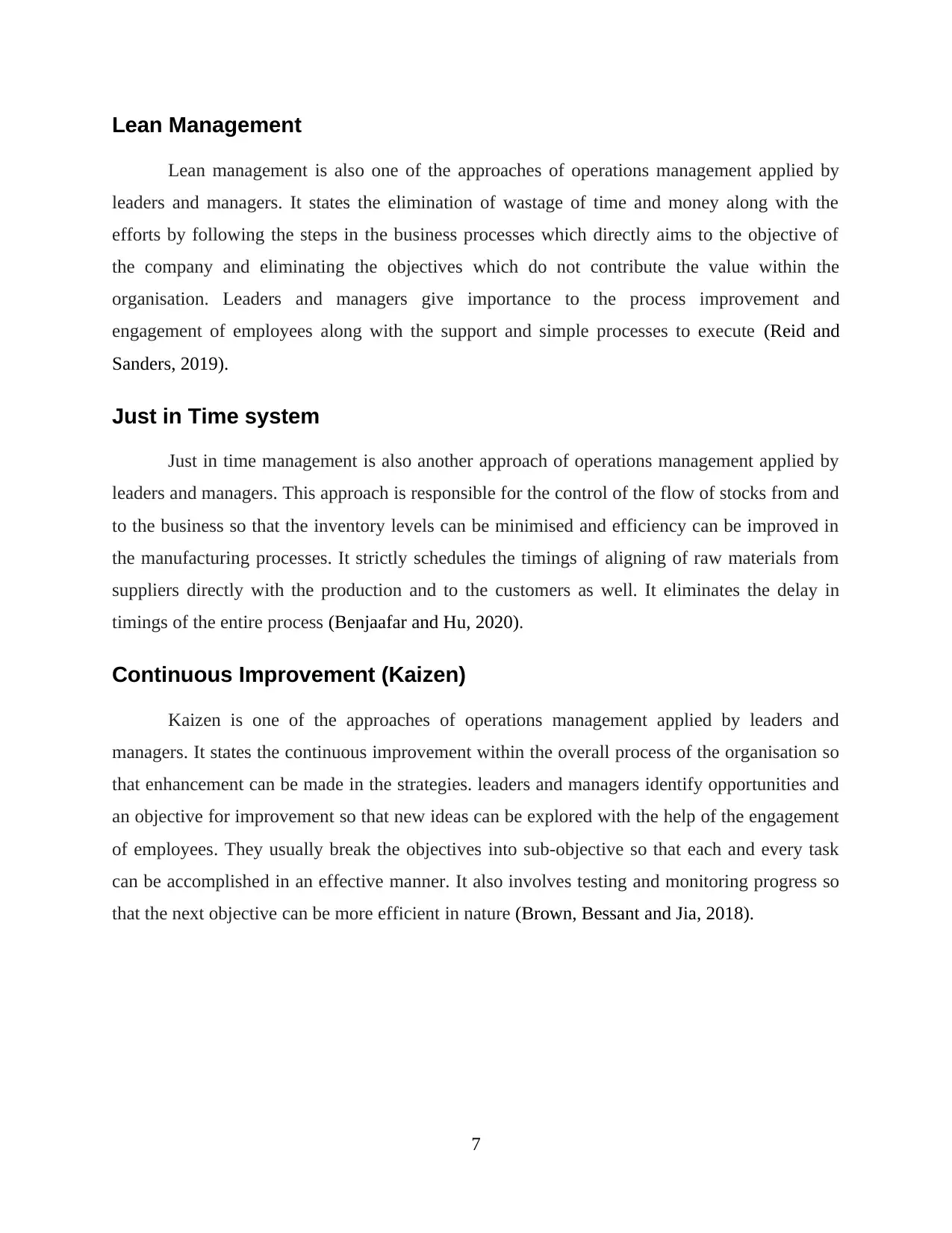
Lean Management
Lean management is also one of the approaches of operations management applied by
leaders and managers. It states the elimination of wastage of time and money along with the
efforts by following the steps in the business processes which directly aims to the objective of
the company and eliminating the objectives which do not contribute the value within the
organisation. Leaders and managers give importance to the process improvement and
engagement of employees along with the support and simple processes to execute (Reid and
Sanders, 2019).
Just in Time system
Just in time management is also another approach of operations management applied by
leaders and managers. This approach is responsible for the control of the flow of stocks from and
to the business so that the inventory levels can be minimised and efficiency can be improved in
the manufacturing processes. It strictly schedules the timings of aligning of raw materials from
suppliers directly with the production and to the customers as well. It eliminates the delay in
timings of the entire process (Benjaafar and Hu, 2020).
Continuous Improvement (Kaizen)
Kaizen is one of the approaches of operations management applied by leaders and
managers. It states the continuous improvement within the overall process of the organisation so
that enhancement can be made in the strategies. leaders and managers identify opportunities and
an objective for improvement so that new ideas can be explored with the help of the engagement
of employees. They usually break the objectives into sub-objective so that each and every task
can be accomplished in an effective manner. It also involves testing and monitoring progress so
that the next objective can be more efficient in nature (Brown, Bessant and Jia, 2018).
7
Lean management is also one of the approaches of operations management applied by
leaders and managers. It states the elimination of wastage of time and money along with the
efforts by following the steps in the business processes which directly aims to the objective of
the company and eliminating the objectives which do not contribute the value within the
organisation. Leaders and managers give importance to the process improvement and
engagement of employees along with the support and simple processes to execute (Reid and
Sanders, 2019).
Just in Time system
Just in time management is also another approach of operations management applied by
leaders and managers. This approach is responsible for the control of the flow of stocks from and
to the business so that the inventory levels can be minimised and efficiency can be improved in
the manufacturing processes. It strictly schedules the timings of aligning of raw materials from
suppliers directly with the production and to the customers as well. It eliminates the delay in
timings of the entire process (Benjaafar and Hu, 2020).
Continuous Improvement (Kaizen)
Kaizen is one of the approaches of operations management applied by leaders and
managers. It states the continuous improvement within the overall process of the organisation so
that enhancement can be made in the strategies. leaders and managers identify opportunities and
an objective for improvement so that new ideas can be explored with the help of the engagement
of employees. They usually break the objectives into sub-objective so that each and every task
can be accomplished in an effective manner. It also involves testing and monitoring progress so
that the next objective can be more efficient in nature (Brown, Bessant and Jia, 2018).
7
⊘ This is a preview!⊘
Do you want full access?
Subscribe today to unlock all pages.

Trusted by 1+ million students worldwide
1 out of 17
Related Documents
Your All-in-One AI-Powered Toolkit for Academic Success.
+13062052269
info@desklib.com
Available 24*7 on WhatsApp / Email
![[object Object]](/_next/static/media/star-bottom.7253800d.svg)
Unlock your academic potential
Copyright © 2020–2025 A2Z Services. All Rights Reserved. Developed and managed by ZUCOL.




